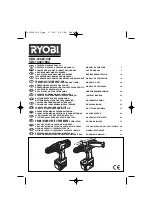
OPERATION
SWITCH LOCK
See Figure 6.
The switch trigger can be locked in the OFF position.
This feature can be used to prevent the possibility of
accidental starting when not in use. To lock switch trigger,
place the direction of rotation selector (Forward/Reverse
Selector) in center position.
Note:
When selector is in center position, switch trigger
is locked.
REVERSIBLE
See Figure 6.
This tool has the feature of being reversible. The direction
of rotation is controlled by a selector located above the
switch trigger. With the drill held in normal operating
position, the direction of rotation selector should be
positioned to the left of the switch for drilling. The drilling
direction is reversed when the selector is to the right of
the switch. When the selector is in center position, the
switch trigger is locked. To stop, release switch trigger and
allow the chuck to come to a complete stop.
ELECTRIC BRAKE
This drill has an electric brake. When the trigger switch is
released, the chuck stops turning. When the brake is
functioning properly, sparks will be visible through the
vent slots on the housing. This is normal and is the action
of the brake.
ADJUSTING THE SPEED
See Figure 8.
Follow these steps to adjust the speed.
■
For high speed: Slide the two-speed gear train switch
to “2.”
■
For low speed: Slide the two-speed gear train switch
to "1."
Note:
If you have difficulty changing from one gear
range to the other, turn the chuck by hand until the
gears engage.
CAUTION
To prevent gear damage, always allow chuck to
come to a complete stop before changing the
speed or the direction of rotation.
KEYLESS CHUCK
See Figure 7.
Your drill has a keyless chuck. As the name implies,
you can hand tighten or release drill bits in the
chuck jaws. Rotate the chuck with your hand.
Rotate the chuck body with your other hand. The arrows
on the chuck indicate which direction to rotate the chuck
body in order to LOCK (tighten) or UNLOCK (release) the
drill bit.
WARNING
Do not hold chuck body with one hand and use
power of the drill to tighten chuck jaws on drill bit.
Chuck body could slip in your hand or your hand
could slip and come in contact with rotating drill bit.
This could cause an accident resulting in serious
personal injury.
MAINTENANCE
WARNING
When servicing, use only identical replacement
parts. Use of any other part may create a hazard
or cause product damage.
Avoid using solvents when cleaning plastic parts.
Most plastics are susceptible to damage from various
types of commercial solvents and may be damaged by
their use. Use clean cloths to remove dirt, dust, oil,
grease, etc.
WARNING
Do not at any time let brake fluids, gasoline,
petroleum-based products, penetrating oils, etc.
come in contact with plastic parts. They contain
chemicals that can damage, weaken or
destroy plastic.
Do not abuse power tools. Abusive practices can damage
tool as well as workpiece.
WARNING
Do not attempt to modify this tool or create
accessories not recommended for use with
this tool. Any such alteration or modification is
misuse and could result in a hazardous condition
leading to possible serious personal injury.
ENVIRONMENTAL PROTECTION
Recycle raw materials instead of disposing
as waste. The machine, accessories and
packaging should be sorted for en-
vironmental-friendly recycling.
11
GB
F
D
E
English
I
P
NL
S
DK
N
FIN
GR
H
CZ
RUS
RO
PL
960299052-02.pxd 3/30/04 3:59 PM Page 11
Summary of Contents for CDD-1202
Page 107: ...960299052 02 ...
















































